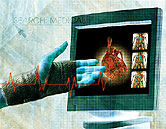 |
 |
 |

ELS Plus CPR Boosts Blood Flow After Cardiac Arrest
Catheter procedure keeps heart tissue alive, benefits other organs, study finds|
|
HealthDay
By Robert Preidt
Wednesday, July 9, 2008
 WEDNESDAY, July 9 (HealthDay News) -- Compared to CPR alone, adding extracorporeal life support doubles survival in hospital patients with cardiac arrest, says a study by researchers at the National Taiwan University Hospital.
WEDNESDAY, July 9 (HealthDay News) -- Compared to CPR alone, adding extracorporeal life support doubles survival in hospital patients with cardiac arrest, says a study by researchers at the National Taiwan University Hospital.
In ELS, a catheter is inserted into a leg artery/vein. The patient receives CPR until the start of ELS, at which point blood travels through the catheter via a pump, heat exchanger and oxygenator before returning to the body. ELS enhances coronary blood flow and keeps heart tissue alive. It also supplies blood to other organs, according to background information in the study.
While patients are receiving ELS, doctors can diagnose the cause of cardiac arrest and begin treatment. And because ELS can be used to control blood temperature, hypothermia (low body temperature) can be induced if required to protect the patient from brain damage.
In this study, the researchers assessed outcomes among cardiac arrest patients who'd undergone CPR for more than 10 minutes. The survival rate decreases rapidly when CPR exceeds 10 minutes. The patients in this study were assigned to receive conventional CPR group (113) or ELS and CPR (59).
Patients who received ELS had a better survival rate to discharge, better 30-day survival, and better one-year survival. For each of these endpoints, patients who received ELS were about half as likely to die as those who received CPR alone, according to the study, which was published in the current issue of The Lancet.
"Future studies should use subgroups of patients with cardiac arrest of cardiac origin and no response to the conventional CPR for more than 10 minutes who are likely to benefit from extracorporeal life-support. Moreover, if progress is satisfactory, we expect that patients getting conventional CPR will benefit from extracorporeal life-support in the near future," Drs. Sung-Woo Lee and Yun-Sik Hong, of the Korea University Ansan Hospital Emergency Department, in Seoul, South Korea, wrote in an accompanying comment.
HealthDay
Copyright (c) 2008 ScoutNews, LLC. All rights reserved.
Related News:
More News on this Date
Related MedlinePlus Pages:
| Home | Health Topics | Drugs & Supplements | Encyclopedia | Dictionary | News | Directories | Other Resources | |
| Disclaimers | Copyright | Privacy | Accessibility | Quality Guidelines U.S. National Library of Medicine, 8600 Rockville Pike, Bethesda, MD 20894 National Institutes of Health | Department of Health & Human Services |
Date last updated: 10 July 2008 |




